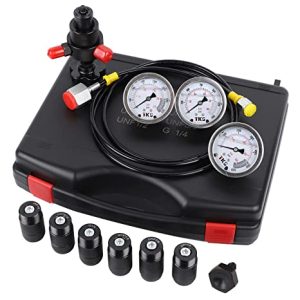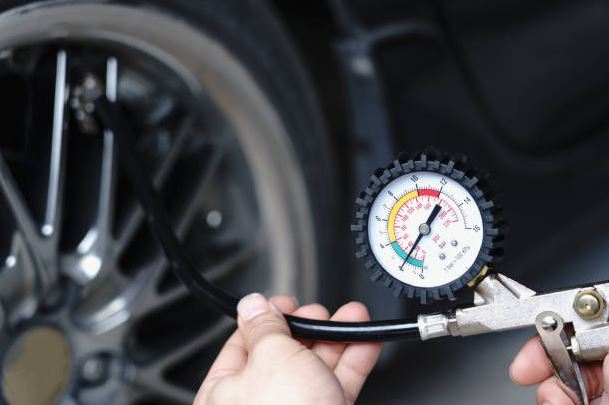You can’t tell if a tire is filled with nitrogen or air by just simply looking at the tire.
The common way to identify a nitrogen-filled tire is by fixing a compact nitrogen analyzer to the tire’s valve cap. This will display the percentage of nitrogen gas in the tire. The tire is inflated with nitrogen if the analyzer reads 95 percent or more.
However, a reading with 78 percent nitrogen means the tire is air-filled. If the percentage falls between 80 to 95 percent, the tire is filled with a mixture of nitrogen and air.
Meanwhile, it’s quite challenging to use a nitrogen analyzer. But, as a technician who has to fix multiple tire problems day in and day out, there is a simple way I identify nitrogen-filled tires.
Table of Contents
Simple Way To Tell a Tire is Filled With Nitrogen
Instead of a Nitrogen analyzer, you can use a green N2 (signifying nitrogen) button on the top of the tire’s original valve stem cap. Many vehicle owners use this method since it is more straightforward.
Filling your tires with nitrogen instead of air has many benefits and tradeoffs. Since nitrogen seeps out of tires more slowly than compressed air would, it will extend the tire life, reduce uneven tread wear, and even increase gas mileage.
However, using nitrogen-filled tires involves responsibilities, including regular checks and frequent inflation.
Now that you know how to identify a tire filled with nitrogen, we will run through the steps involved in checking the tire pressure in nitrogen tires and other relevant answers to nitrogen tire questions.
Can You Plug A Tire Filled With Nitrogen?
In the event of a puncture, the gas in your tire is irrelevant with using a puncture sealant. After all, compressed air contains 80 percent nitrogen.
Plugging a nitrogen-filled tire could muck up the inside of the tire and damage the TPMS sensor stem and the valve seal.
Tire dealers recommend not to plug a tire filled with nitrogen since it can throw your tire’s balance out to the wind.
Can You Put Air In A Tire Filled With Nitrogen?
Yes, you can. There is nothing dangerous in putting air in a tire previously filled with nitrogen. Again, compressed air is made up of about 78 percent nitrogen, 20 to 21 percent oxygen, and 1 to 2 percent water vapor and other gases.
The only thing you should be concerned about when topping off a nitrogen-inflated tire with air is the possibility of diluting the purity of the nitrogen. As a result, all the benefits of using an effective nitrogen-filled tire will decrease.
So you can put air in a nitrogen filled tire as both gases do not react adversely.
Do Tires Fill With Nitrogen Lose Pressure In Cold?
Nitrogen is a gas and can’t twist the law of physics. It will be affected by ambient temperature drops during the fall/winter months. As tire pressure drops, the nitrogen-filled tire will require pressure add-up (more on this shortly)
Meanwhile, the molecules in nitrogen are bigger than those in normal air. So they barely leak out, so they will maintain air pressure longer.
How Do I Check Nitrogen Tire Pressure?
As mentioned earlier, regular checks and inflation are part of nitrogen-inflated tire users’ responsibility. The steps I use to check the tire pressure of my nitrogen-filled tires are the same as those of tires filled with compressed air.
First, you need to find out the recommended tire pressure for your vehicle, then unscrew/remove the valve cap from one of the tires.
Afterward, take the tire’s valve stem and connect it to the inflow valve of your tire pressure gauge. The current inflation of the tire will be displayed. Note this down, then disconnect the gauge from the tire’s valve stem.
The tire pressure may be low, so you need to add nitrogen. If otherwise, you are good to go. Then, replace the valve stem cap and repeat the process for the other tires on your vehicle.
Nitrogen Vs. Compressed Air: Which Is Better for Your Car Tires?
There is quite a trendy debate over whether nitrogen or compressed air is better for inflating tires. But, of course, the ultimate decision is influenced by your preference.
If you have a nearby nitrogen source, are willing to observe regular pressure checks, and prioritize optimal tire performance, then nitrogen is worth your shot (and the extra cost.)
If these caveats don’t sit right with you, you are better off inflating with compressed air.
Moreover, unlike air, nitrogen will maintain its inflation longer and improve overall vehicle handling.
Also, since they do not introduce any water into the tire, there is no corrosion. But skeptics would point out that nitrogen refills aren’t as readily available as air, and the cost of getting refills can be as high as $7 per liter for a top-off.
In summary
The use of nitrogen-inflated tires is catching on with many vehicle owners. In the above article, we have looked at the two common (and pretty straightforward) ways to tell if a tire is filled with nitrogen or compressed air.
- By using a Nitrogen analyzer
- By replacing the actual valve seal cap with a green N2 button on its top
P.S. A portable nitrogen analyzer can set you back around $200. I use this Portable Nitrogen Dioxide Detector 0-20 PPM Range with LCD Display Backlit, which I purchased for $282 on Amazon.

Remember, using puncture sealant on nitrogen-filled tires can damage your TPMS sensor stem and the valve seal. But there is nothing wrong with putting air in a tire that has previously been inflated with nitrogen.
Let me know in the comments if you have any doubts about using nitrogen to inflate your tires.

